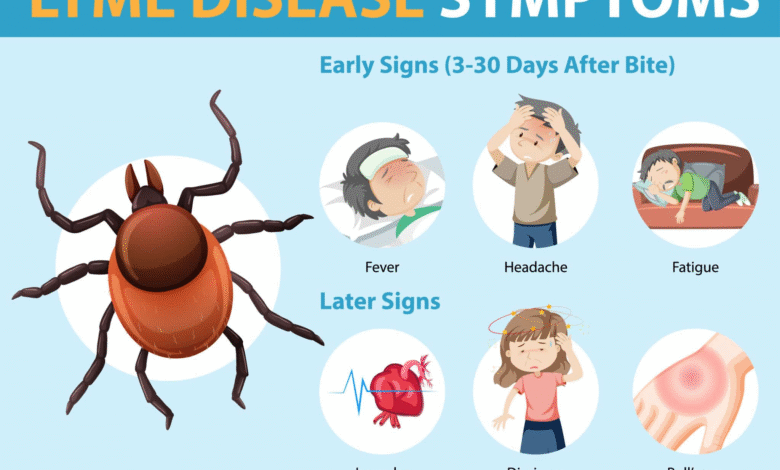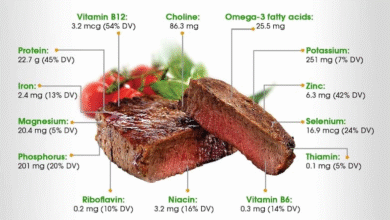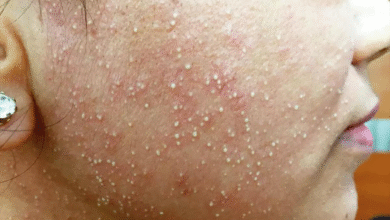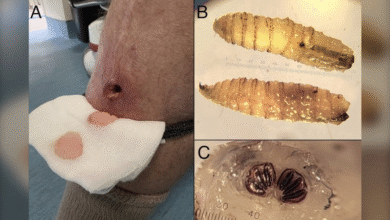Lyme Disease: Symptoms, Prevention, and Treatment Guide

Lyme disease is an emerging health concern, particularly during the warmer months in the Northeast, Mid-Atlantic, and upper-Midwest regions of the U.S. This bacterial infection, caused by Borrelia burgdorferi and transmitted through tick bites, can lead to serious complications if not treated promptly. Common Lyme disease symptoms include a distinctive bull’s-eye rash, muscle pain, and neurological issues, which often manifest weeks after a tick bite goes unnoticed. Understanding how to effectively prevent Lyme disease and seeking timely Lyme disease treatment are crucial for avoiding long-term health problems, such as chronic Lyme disease. With increasing reports of Lyme cases, awareness and preventive strategies are more important than ever in safeguarding your health.
Often referred to as a tick-borne illness, Lyme disease signifies a growing threat within certain geographic areas, marked by its transmission through the bite of infected deer ticks. These diminutive pests are notorious for their ability to go unnoticed, potentially leading to a range of health complications, from joint pain to serious neurological conditions. Recognizing early signs, like the characteristic circular rash or fatigue, is essential for prompt Lyme disease intervention. Preventative measures against tick bites are vital, including effective strategies to reduce exposure in tick-populated regions. As awareness rises, both the public and healthcare professionals must remain vigilant in combating this preventable yet potentially debilitating condition.
Understanding Lyme Disease Symptoms
Lyme disease symptoms can vary significantly among individuals, but some common early signs include fatigue, fever, and muscle aches. These symptoms often appear within a few days or weeks of being bitten by an infected tick. A hallmark of Lyme disease is the characteristic bull’s-eye rash, though not everyone develops this noticeable skin symptom. In fact, studies indicate that approximately 60% to 80% of patients exhibit this rash, which typically starts as a red spot then expands into a circular shape with a lighter center, resembling a target. Recognizing these early symptoms is crucial for timely treatment and management of the disease.
As Lyme disease progresses, untreated symptoms can escalate to severe complications affecting multiple body systems. This can manifest as Lyme arthritis, where lasting inflammation leads to joint pain, or neurological issues like Lyme meningitis, which presents severe headaches and stiff neck. Furthermore, ongoing fatigue and joint pain can persist even after initial treatment, highlighting the importance of immediate medical consultation if Lyme disease symptoms emerge.
Effective Lyme Disease Treatment Options
The standard treatment for Lyme disease usually involves a course of antibiotics, predominantly doxycycline, amoxicillin, or cefuroxime axetil. These medications are often effective, particularly when initiated early in the course of the disease. According to experts, if treatment commences within the first few days following a tick bite or upon the emergence of rashes, the prognosis is often very positive. However, timing is critical; treatment within three days of tick removal has been shown to effectively prevent the progression of the disease.
For patients experiencing persistent symptoms even after antibiotic treatment, this condition is often referred to as chronic Lyme disease or post-treatment Lyme disease syndrome (PTLDS). Managing these lingering symptoms can be challenging and typically involves a comprehensive approach, including symptom management therapies rather than additional rounds of antibiotics. Patients are encouraged to discuss their ongoing symptoms with healthcare providers to explore options that may include physical therapy, pain management, and alternative treatments.
Preventing Lyme Disease: Essential Strategies
Preventing Lyme disease is possible through proactive measures aimed at avoiding tick bites. Making lifestyle adjustments during outdoor activities can significantly diminish the risk of exposure. Experts recommend wearing protective clothing such as long sleeves and pants, along with using tick repellents that contain DEET or picaridin, particularly when venturing into wooded or grassy areas. Additionally, regularly conducting tick checks of the body after hiking or spending time outdoors can help identify any ticks before they have an opportunity to bite.
Another vital aspect of prevention is understanding how to properly remove ticks. If a tick is found on the skin, it should be removed using fine-tipped tweezers, pulling upward gently yet firmly to ensure the entire tick is extracted, including its head. After removal, the bite area should be washed thoroughly with soap and water. By adhering to these preventive measures, individuals can significantly reduce their chances of contracting Lyme disease and its associated complications.
The Importance of Tick Bite Prevention
Tick bite prevention is crucial in managing Lyme disease risk. Taking simple, yet effective, steps can drastically reduce your likelihood of encountering ticks. This includes delaying outdoor activities during peak tick season, particularly in regions known for higher incidences of Lyme disease, such as the Northeast and upper Midwest of the U.S. Furthermore, when hiking or camping, sticking to cleared paths and avoiding tall grass or dense brush can also limit exposure to ticks. Understanding the peak activity times for ticks, especially in warm weather, is essential for effective prevention.
In addition to proactive measures, educating oneself and others about tick habitats and behavior can bolster prevention efforts. It’s important to spread awareness about not only what ticks look like but also where they are most commonly found, such as wooded areas or grassy fields. Utilizing tick-safe zones in your yard, including creating a barrier of wood chips or gravel between lawns and wooded areas, can create a less inviting environment for ticks. Staying informed about safe practices and sharing that knowledge within your community can make a significant difference in combating Lyme disease.
Recognizing Chronic Lyme Disease
Chronic Lyme disease, or post-treatment Lyme disease syndrome (PTLDS), refers to a condition where individuals continue to experience debilitating symptoms after completing an antibiotic treatment regimen. The symptoms can include persistent fatigue, joint pain, and cognitive dysfunction, which can drastically affect the quality of life for those affected. Many patients express frustration, as standard tests often do not confirm ongoing infection, leading healthcare providers to focus on symptom management instead.
Recognizing chronic Lyme disease is essential for appropriate care. The complexity of the symptoms can resemble other chronic illnesses, making diagnosis challenging. Patients experiencing prolonged symptoms after initial Lyme disease treatment should advocate for comprehensive evaluations with their healthcare providers. This may involve exploring alternative treatment options, therapy for symptom relief, and possibly addressing other tick-borne diseases that might complicate recovery. Support groups and educational resources can also provide vital information for managing chronic Lyme disease effectively.
The Role of Diagnosis in Lyme Disease Management
Accurate and timely diagnosis of Lyme disease is pivotal for effective treatment. Healthcare providers often rely on a combination of patient history, symptom presentations, and laboratory testing to confirm an infection. The unique red bull’s-eye rash is a significant indicator, but in absence of this, healthcare professionals may utilize blood tests to detect antibodies against the Borrelia bacteria. However, these tests have limitations, and results can sometimes yield false negatives, particularly in the early stages of the disease when antibody levels are low.
Understanding the importance of diagnosis can empower patients to seek prompt medical attention when they suspect they have been exposed to Lyme disease. Keeping a record of symptoms and potential tick exposures can also provide valuable information to healthcare providers. This proactive approach can not only lead to faster treatment but significantly enhance chances for a full recovery from Lyme disease.
Emerging Areas of Lyme Disease Cases
Recent trends have indicated that Lyme disease is not confined to its historical strongholds but is now expanding into new geographical regions. Reports from the CDC indicate that areas well beyond the Northeast and Upper Midwest are experiencing increases in Lyme disease cases. Changes in climate, along with the shifting habitats of ticks, are believed to be significant factors in this expansion, altering the landscape of where Lyme disease is a threat.
As Lyme disease cases emerge in new regions, public awareness becomes increasingly crucial. Communities should educate themselves about the signs and symptoms of Lyme disease, especially if they reside in areas where Lyme disease was previously rare. Local health departments can also play a role in disseminating information about prevention and treatment options, ensuring that residents are equipped with the knowledge necessary to protect themselves and their families.
Clinical Studies on Lyme Disease Treatment
Ongoing clinical studies continue to explore effective treatment options for Lyme disease, especially as cases of chronic Lyme disease present significant challenges to standard care. Research is examining new antibiotics, alternative therapies, and the impact of prolonged treatment courses for patients experiencing persistent symptoms. These studies are critical not only for improving patient outcomes but also for enhancing the overall understanding of the infection mechanisms of Borrelia burgdorferi.
As researchers investigate innovative strategies for managing Lyme disease, patient involvement remains essential. Participants in clinical studies contribute valuable data that can shape future treatment protocols. Educating patients about emerging research can empower them to engage actively in discussions with their healthcare providers, potentially leading to more personalized and effective treatment plans.
The Future of Lyme Disease Prevention Strategies
The future of Lyme disease prevention is likely to involve a multi-faceted approach that includes advances in technology, education, and community engagement. From developing more effective tick repellents to the potential of vaccines, ongoing research is essential in reducing incidence rates and improving awareness. Education initiatives tailored toward high-risk populations can further enhance understanding of how to effectively prevent tick bites and recognize Lyme disease symptoms early.
Furthermore, collaborations among public health organizations, researchers, and communities can create comprehensive prevention strategies that utilize shared knowledge and resources. As more is understood about the ecological factors influencing tick populations, targeted prevention campaigns can be more effectively designed to meet the challenges posed by the evolving landscape of Lyme disease.
Frequently Asked Questions
What are the common Lyme disease symptoms to watch for after a tick bite?
Common Lyme disease symptoms typically appear within two weeks of a tick bite and may include extreme fatigue, joint pain, fever, and the characteristic red, circular bull’s-eye rash. It’s crucial to monitor for additional signs like headaches, neck stiffness, and facial paralysis.
How can I prevent Lyme disease when spending time outdoors?
To prevent Lyme disease, take precautions such as wearing long sleeves and pants, applying tick repellents that contain DEET, and performing tick checks on your body after outdoor activities. Showering after being in wooded or grassy areas and properly removing any ticks found are also essential.
What is the recommended Lyme disease treatment if I suspect I have been infected?
If you suspect Lyme disease, it’s important to consult a healthcare provider promptly. Early treatment typically involves a course of antibiotics, such as doxycycline, especially if administered within 72 hours of a high-risk tick bite.
What does chronic Lyme disease entail, and how is it treated?
Chronic Lyme disease, also known as post-treatment Lyme disease syndrome (PTLDS), may affect some patients who continue to have symptoms after treatment. Management usually focuses on symptomatic relief rather than additional antibiotics, and doctors may check for other tick-borne illnesses.
What should I do if I find a tick on my body?
If you find a tick, remove it immediately using fine-tipped tweezers by pulling straight up with steady, even pressure. Clean the bite area with soap and water afterward. Monitor for any symptoms of Lyme disease, and consider consulting a healthcare provider.
How effective are Lyme disease blood tests for diagnosis?
Blood tests can be used to diagnose Lyme disease, but timing is critical. It’s best to consult a healthcare provider as soon as symptoms appear or after a tick bite for appropriate evaluation and potential early treatment.
What are the stages of Lyme disease and their associated symptoms?
Lyme disease progresses through early localized infection, early disseminated infection, and late disseminated infection. Early stages often present with fatigue and rash, while late stages may involve severe joint pain and neurological symptoms, requiring medical attention.
Are there any long-term effects of Lyme disease treatment?
Some individuals may experience long-term effects, known as chronic Lyme disease or PTLDS, following treatment. Symptoms can persist even after appropriate antibiotic therapy is completed, requiring symptom management and further evaluation by a physician.
| Key Points |
|---|
| Lyme disease is prevalent during certain seasons, especially in NE, mid-Atlantic, and upper-Midwest U.S. |
| Caused by the Borrelia burgdorferi bacterium, transmitted through black-legged (deer) ticks. |
| Ticks can be very small (size of a poppy seed) and may cause unnoticed bites due to a numbing agent. |
| Symptoms include muscle/joint pain, fatigue, rash, fever, and neurological issues. |
| A red, circular bull’s-eye rash appears in 60%-80% of cases. |
| Untreated, symptoms can escalate to severe neurological and cardiac issues. |
| Blood tests are used for diagnosis; timely tick removal is crucial. |
| Post-exposure prophylaxis with antibiotics is recommended after high-risk tick bites. |
| Chronic Lyme disease may occur after treatment; symptoms are managed symptomatically. |
| Preventive measures include tick checks, wearing protective clothing, and using repellents. |
Summary
Lyme disease is a significant health concern, particularly during the spring and summer months when ticks are most active. It is crucial to be aware of the symptoms and preventative measures for avoiding tick bites. Early detection and treatment are essential to prevent severe health complications associated with Lyme disease. Individuals should regularly check for ticks after outdoor activities, seek prompt medical attention after tick bites, and consider vaccination and preventive strategies to reduce the risk of Lyme disease.




